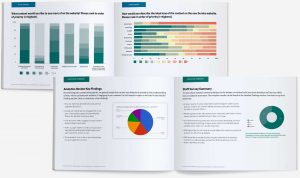We have a lot of clients who come to us with clearly defined priorities for their branding and design projects. Often they’ve identified their problems and the solutions—they’re looking for a partner to simply execute their vision. We think as an agency, we sell our clients short if we take all of their priorities as gospel. In fact, our process is designed to first ask Why, not How, we’ll deliver the goods.
You Know What they Say about Assuming…
One of the most important roles we can play as strategic partners is to identify and politely probe at our clients’ assumptions. We want to make sure that we’re fully understanding our clients’ problems and needs before we all agree on solutions. My worst fear (OK there are worse ones if I’m honest) is establishing a strategy based a faulty hunch and then realizing half-way through the project that we’ve made a poor decision, wasting time and money.
To make this more tangible, here’s how these assumptions/push-back typically plays out:
Client: We’ve heard from our constituents that they struggle to find our offices [Problem]. A priority for our new website is an interactive map that shows every one of our offices [Solution based on Assumptions].
Now, we’re confident that we can make a great interactive map. But are we absolutely sure that the interactive map is a solution to this client’s challenge?
This is a perfect opportunity to dissect the problem and identify questions we need answers to. Perhaps we should ask who can’t find the offices? How are they searching for them? What information are they finding and not finding?
Probing assumptions at the beginning of a project almost invariably confirms the need to speak directly with the people who will use your website, interact with your designs, or read your messages. There are countless examples of user research providing completely unexpected and critical insight for projects. By asking questions that shed light on our information gaps related to our audiences, we’re able to prioritize learning about their needs and perspective.
So short of employing the somewhat reductive 5 Whys Method (which we still dig in the right setting), how do we structure engagements to focus on the right questions, get answers, and not move at a glacial pace?

Putting Inquiry into Practice
In a nutshell, as we begin the Discovery phase of a project, our team focuses our energy on identifying all of our information gaps and any assumptions. From there, we group these questions thematically into areas of inquiry. Then we try to capture these areas of inquiries in 3-5 specific and concise Key Discovery Questions that we’ll present to our clients and use to guide our research activities.
To make this slightly less abstract, I’ll use a (very silly) example:
The Society for the Promotion of Nontoxic Spoons, (SPNS) partners with us to design a new website. They tell us one of their primary goals is to create a more user-friendly knowledge hub that will drive traffic to their plethora of thought leadership on spoons. They tell us the current knowledge hub is difficult to navigate and search.
First, we begin by listing all of the questions we have about SPNS, their audiences, their thought leadership, and their current website. From a long list, we’re able to focus our areas of inquiry on several Key Discovery Questions:
- Who is currently reading your thought leadership?
- Are these your target audiences?
- What information do your target audiences need and how do they need it delivered?
After sharing and refining our list of Key Discovery Questions with SPNS, we design a set of sub-questions that we’ll ask over the course of our research to gain deeper insight. Then we establish which research activities will help us get answers to these questions. To stick with our ridiculous example:
- Who’s currently reading your thought leadership? → What can analytics tell us about their behavior? (Analytics Review)
- Are these your target audiences?→ What do you hope to achieve with each audience? What specific actions do you want each audience to take on your website? How do these actions serve your broader mission? (Staff Survey & Workshop)
- What information do your target audiences need and how do they need it delivered? → Why and how do users find their way to the website, and the knowledge hub specifically? How do they prefer to consume information? (User Research)
I’d love to go into the details of our research intake process here, but it’s probably best to save that for a future insight. Regardless, once we’ve finished our intake, it’s time to make sense of our findings in order to present them in a way that establishes clear recommendations/priorities for executing future work. For digital projects, like PHI or Surdna Foundation, these recommendations often take the shape of business requirements and a project roadmap. Similarly, for brand strategy projects, we present a brand assessment and project roadmap. In both cases, our Key Discovery Questions serve as both a framework for structuring our findings and recommendations and provide a strong foundation from which to launch a project.

Summing Up
Exhausted yet? It’s a lot of inquiry. It might be easier to just build the interactive map or the knowledge hub. But the question-asking pays off when we have a ton of data and insights to back up our conclusions. We’re able to set priorities and measurable goals for the project based on a broader perspective on our client’s challenges and their audience’s needs. And perhaps most importantly, we establish an ethos for the rest of the project around testing assumptions and exploring ideas that will serve all of us as we navigate decision-making. With a little luck, our partners will be on board with the idea of continuing to test our work as we move into the execution phases with message testing, user-research, and prototyping




